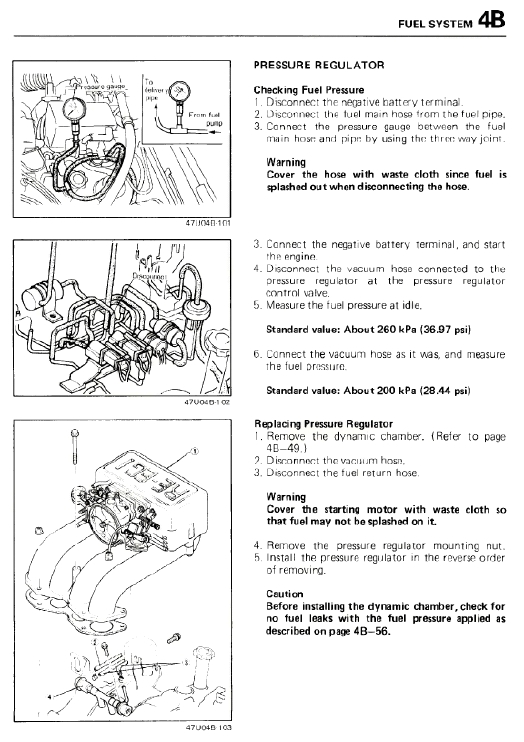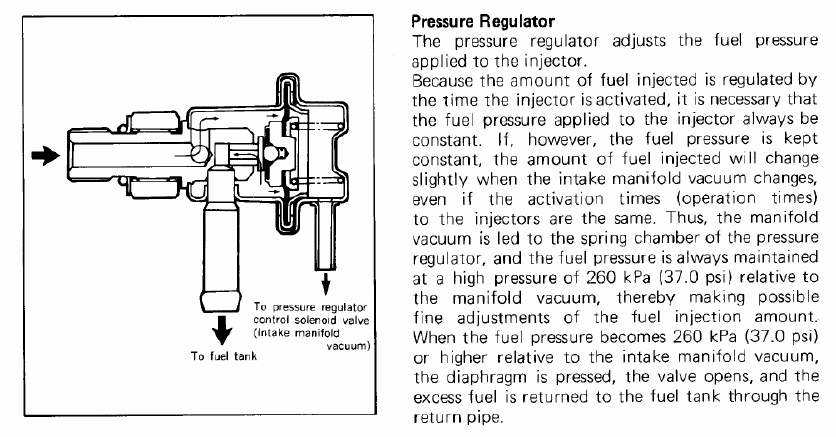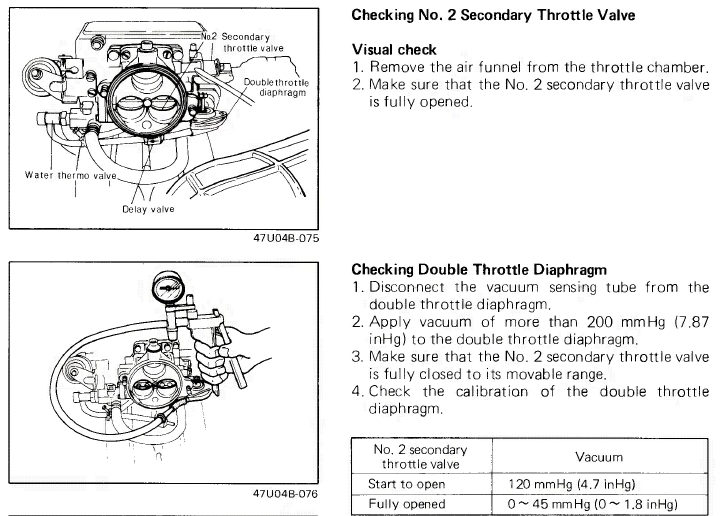85 GSL-SE Cutting out at 6K RPM
#1
85 GSL-SE Cutting out at 6K RPM
My car seems to hit a wall so to speak at around 6k rpm under full throttle but runs beautifully otherwise. I've managed to feather it past 6000 to near redline with moderate throttle though. It almost feels like hitting a rev limiter
Car sat for 5 years so let me update you on what has been done: Starting with the fuel tank I had it professionally cleaned and sealed, new fuel pump, fuel filter, replaced all rubber fuel lines, blew out hard fuel lines with high pressure air, had fuel injectors cleaned by witch hunter as well as replace fuel injector plugs, replaced all the vacuum lines, new plugs, cap, rotor, coils and wires, adjusted timing (both leading and trailing), adjusted TPS (with plug light from mazda trix), replaced BAC valve, tested vent solenoid valve- passed, tested vacuum solenoid valve - passed, new computer, replaced the pre-cats and cat pipe with a new piece from Rotary Performance and many other things that are not relevant to the problem (ie: belts, hoses, brake booster, master cylinder, rebuilt tranny, brake lines not to mention the cosmetic restoration in progress).
I know there is a multitude of subsystems and solenoids I have not tested but I've been basically hunting down one issue at a time up to this point and with much success. As I've stated in my profile, I picked up this car for $250 not running. To get it this far without changing the motor is really surprising to me and I think if I can continue to dial it in it will run for a few years to come.
Any ideas on where I should start next? Thanks.
Car sat for 5 years so let me update you on what has been done: Starting with the fuel tank I had it professionally cleaned and sealed, new fuel pump, fuel filter, replaced all rubber fuel lines, blew out hard fuel lines with high pressure air, had fuel injectors cleaned by witch hunter as well as replace fuel injector plugs, replaced all the vacuum lines, new plugs, cap, rotor, coils and wires, adjusted timing (both leading and trailing), adjusted TPS (with plug light from mazda trix), replaced BAC valve, tested vent solenoid valve- passed, tested vacuum solenoid valve - passed, new computer, replaced the pre-cats and cat pipe with a new piece from Rotary Performance and many other things that are not relevant to the problem (ie: belts, hoses, brake booster, master cylinder, rebuilt tranny, brake lines not to mention the cosmetic restoration in progress).
I know there is a multitude of subsystems and solenoids I have not tested but I've been basically hunting down one issue at a time up to this point and with much success. As I've stated in my profile, I picked up this car for $250 not running. To get it this far without changing the motor is really surprising to me and I think if I can continue to dial it in it will run for a few years to come.
Any ideas on where I should start next? Thanks.
#3
Engine will redline w/o aux ports opening, as will a carbed engine w/o the secondaries opening. May take a little longer to get there. Feathering the throttle suggests a fuel supply problem. Since you had the tank serviced, I'd pull the fuel pickup and see if some of the tank sealer is restricting the pickup tube. Might want to check fuel pressure under load as it approaches 6k rpm.
#4
Wasn't any actual sealer used because of baffles. It was just a light oil. Pickup should be fine. I'm thinking weak fuel pump or bad regulator???
Anybody have any tips on how to rig up a gauge to check fuel pressure while driving?
Anybody have any tips on how to rig up a gauge to check fuel pressure while driving?
Last edited by slvrghst; 02-07-11 at 10:47 AM.
#5
Light oil doesn't do caca for a rusty tank. Have it cleaned again and seal it yourself. If the baffles were in the way of the sealer spreading throughout the tank, they would be in the way of the fuel too. SE fuel filters can get expensive, how many do you want to replace?
#6
I would agree that it's fuel pressure related. Could be crap in the tank clogging up the pick-up filter, could be the SE EFI Fuel Filter ($$$, as stated above), or fuel pump going bad, and could also be something as simple as a bad vacuum line to the Fuel Pressure Regulator (FPR) at the front of the fuel rail.
All you carb guys can stop reading here. Ahem,...
So, FPR on an SE uses a vacuum source (the intake) to bump up fuel pressure under engine load. This is normally about 40-45psi at idle, and ramps up to 65+psi at WOT, though there's a mechanical limit due to the pressure provided by the fuel pump. The FPR works by closing off a mechanical disk against the outgoing flow from the fuel rail return to 'dead-head' the fuel line and effectively raise pressure at the injectors. If the vacuum line is not connected, you'll never get more than 40-45psi at the rail, and the injectors will be running lean up to redline - i.e., your comment about 'feathering the throttle'. This is not good for the engine.
At the front of the fuel injector rail, follow the feed and return lines and at the forward point of the rail, you'll see a cylindrical brass-colored object with the vacuum line spigot. This is the FPR. Test it by putting a fuel pressure gauge (for EFI pressures...) onto the rail at the banjo bolt, and with the engine running at idle, apply suction to the vacuum line connected to the FPR. The engine should respond by bogging down (excess fuel), drop in idle, and a noticable increase in gauged fuel pressure. If you get nothing with vacuum source, then it's a bad FPR (*or could be a bad pump or clogged filter that can't exceed 40-45psi!).
Filters and fuel lines are EFI-specific (and so-marked), so don't try and use a carb fuel filter - it will burst with disasterous results.
Beyond FPR issues, look closely at your fuel filtering if you can't get good pressure and your pump is good. HTH,
All you carb guys can stop reading here. Ahem,...
So, FPR on an SE uses a vacuum source (the intake) to bump up fuel pressure under engine load. This is normally about 40-45psi at idle, and ramps up to 65+psi at WOT, though there's a mechanical limit due to the pressure provided by the fuel pump. The FPR works by closing off a mechanical disk against the outgoing flow from the fuel rail return to 'dead-head' the fuel line and effectively raise pressure at the injectors. If the vacuum line is not connected, you'll never get more than 40-45psi at the rail, and the injectors will be running lean up to redline - i.e., your comment about 'feathering the throttle'. This is not good for the engine.
At the front of the fuel injector rail, follow the feed and return lines and at the forward point of the rail, you'll see a cylindrical brass-colored object with the vacuum line spigot. This is the FPR. Test it by putting a fuel pressure gauge (for EFI pressures...) onto the rail at the banjo bolt, and with the engine running at idle, apply suction to the vacuum line connected to the FPR. The engine should respond by bogging down (excess fuel), drop in idle, and a noticable increase in gauged fuel pressure. If you get nothing with vacuum source, then it's a bad FPR (*or could be a bad pump or clogged filter that can't exceed 40-45psi!).
Filters and fuel lines are EFI-specific (and so-marked), so don't try and use a carb fuel filter - it will burst with disasterous results.
Beyond FPR issues, look closely at your fuel filtering if you can't get good pressure and your pump is good. HTH,
#7
Thanks longduck.
As I posted before, the tank no longer has rust and was cleaned by a radiator shop, the pickup filter is new, the fuel pump and filter are new. I'm going to try testing the FPR to see if that gives any signs of failure.
As I posted before, the tank no longer has rust and was cleaned by a radiator shop, the pickup filter is new, the fuel pump and filter are new. I'm going to try testing the FPR to see if that gives any signs of failure.
Trending Topics
#9
Uh correct me if im wrong but the FPR is open with vacuum at idle and at WOT (when there is no vacuum) it closes to build pressure applying vacuum to the line at idle will test nothing the fpr can still fail in that it cant hold pressure at wot a loose or cracked vacuum line to the FPR will only make you run rich!
#11
fuel pressure
i had the same problem getting to my presssure regulator. 1st get the factory service manual (you can find it here just search for it) it will show you right where its at and how to remove it if need be. Then hook up a fuel pressure test gauge it goes on your fuel inlet tube on the drivers side of the motor and test it there.
ps.. fuel pressure at idle should be at or around 28-30 psi
good luck man keep us updated
ps.. fuel pressure at idle should be at or around 28-30 psi
good luck man keep us updated

#16
*****UPDATE GUYS**********
Well it passed all the fuel pressure tests we threw at it.
Does anyone know anything about a double throttle diaphragm?? I noticed under full throttle testing that the shaft going into the diaphragm would not move. In. fact, it seemed pretty firm. Is this normal or am I on to something? Could my initial instinct of the secondaries not opening properly be right?
Well it passed all the fuel pressure tests we threw at it.
Does anyone know anything about a double throttle diaphragm?? I noticed under full throttle testing that the shaft going into the diaphragm would not move. In. fact, it seemed pretty firm. Is this normal or am I on to something? Could my initial instinct of the secondaries not opening properly be right?
Thread
Thread Starter
Forum
Replies
Last Post
rgordon1979
3rd Generation Specific (1993-2002)
40
03-15-22 01:04 PM
Jeff20B
1st Generation Specific (1979-1985)
73
09-16-18 08:16 PM





 :
:


